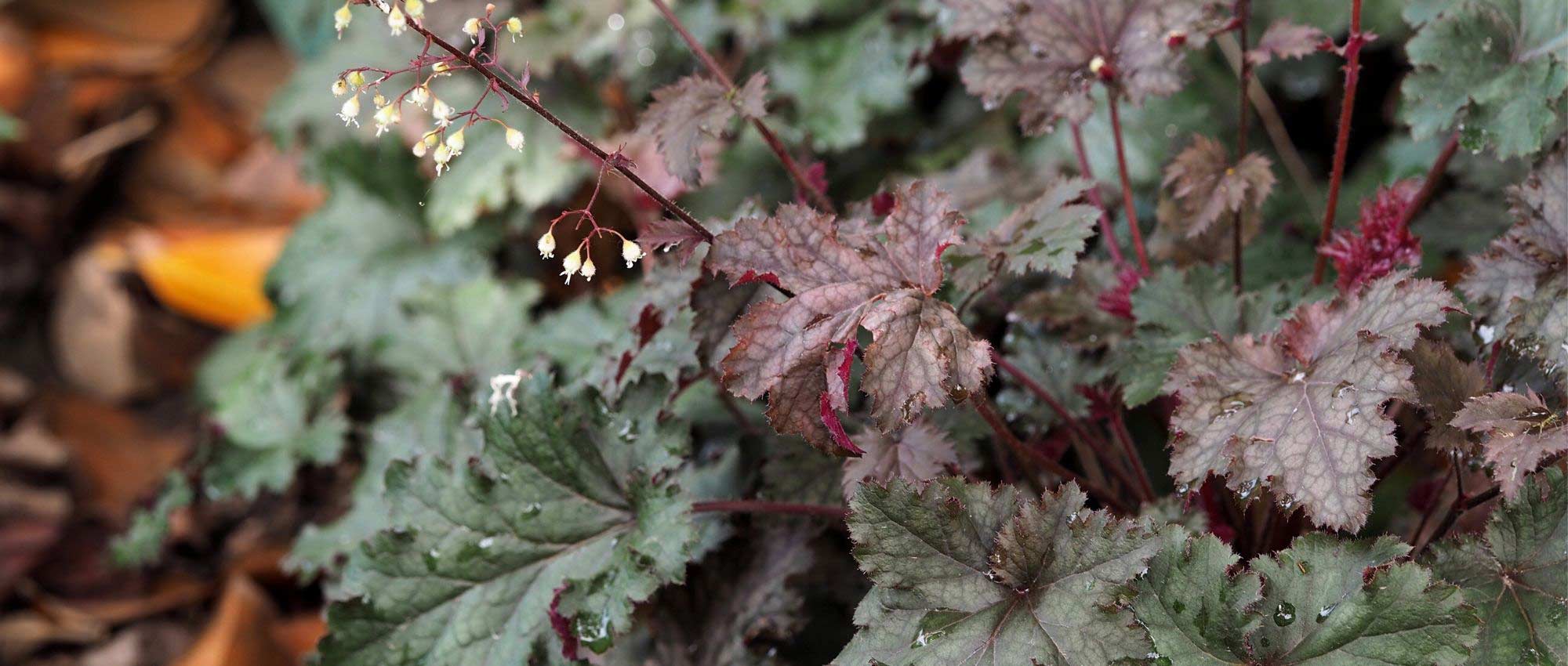
Heuchera: 7 ideas for successful plant combinations
Ideas and inspiration
Contents
Heuchera is a perennial whose leaves declinate in a diversity of exceptional colours! Depending on varieties, they can be dark green, apple green, golden yellow, orange, caramel, pink-red, purple, black… with often very beautiful shades within a single leaf. Thus, Heuchera is in a way a “plant chameleon”: capable, depending on varieties, of adapting to the most varied scenes. It pairs effortlessly with a wide range of plants! It brings brightness to the understorey, enhances flowering, lifts a bed or a floral composition, etc. It can be planted in rockery, in the understorey, in pots, at the foot of trees and bushes… Discover our inspirations and find which plants to pair it with in the garden!
To create contrast with light-coloured foliage
You can create a striking effect by pairing a Heuchera with dark leaves with much lighter foliage, pale green or golden yellow. Choose, for example, Heuchera ‘Black Pearl’ or ‘Obsidian’, and plant alongside it Hakonechloa macra ‘Aureola’, Acorus gramineus ‘Ogon’ and Lysimachia nummularia ‘Aurea’. The colours of these plants are opposite and reinforce each other! The lime-green hue lightens the border and stands out in a very original way alongside the darkest leaves.
In a similar style, you can create a lovely contrast by pairing the dark foliage of Heuchera ‘Plum Pudding’ with the very fine, pale-green leaves of sweet woodruff.
Note that the opposite is also possible: you can pair bright Heucheras, with light yellow-green leaves, with dark foliage: Ophiopogon planiscapus ‘Nigrescens’, Astilbe ‘Chocolate Shogun’, Ligularia dentata ‘Pandora’…
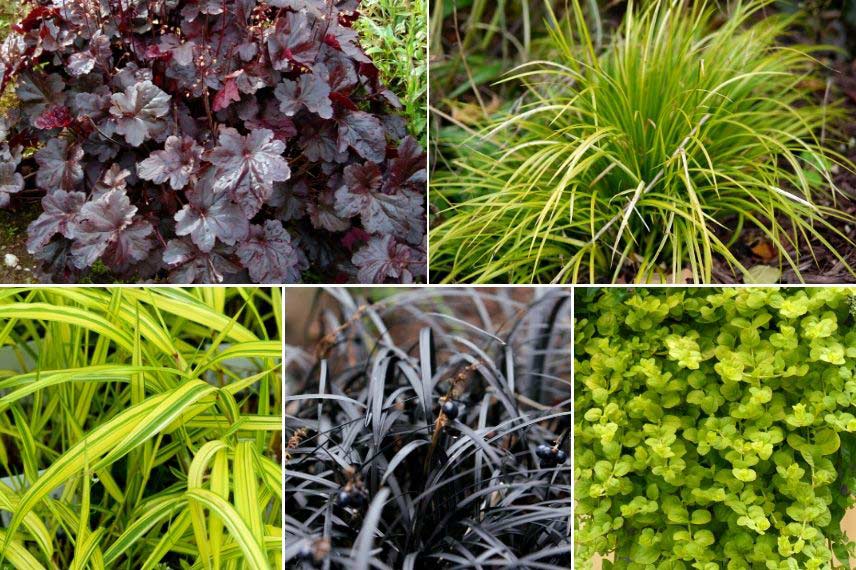
Heuchera ‘Obsidian’, Carex morrowii ‘Aurea variegata’ (photo F.D. Richards) Hakonechloa macra ‘Aureola’, Ophiopogon planiscapus ‘Nigrescens’ (photo brewbooks), and Lysimachia nummularia ‘Goldilocks’
Read also
How to plant heucheras?In a shaded rockery
You can easily create a rockery in shade, for example in an understorey, in a relatively cool spot. Create it on a natural slope or build a mound to raise the soil, then position large stones to stabilise the slope. Plant small perennial plants that form a mat or clump between the stones. Plant your Heuchera alongside grasses such as Carex ‘Evergold’ or Hakonechloa macra ‘Aureola’. You can also plant Tiarella wherryi, a superb perennial with soft green foliage that produces feathery, pink-tinged flowers from mid spring through summer. Enjoy also the splendid foliage of fern Asplenium scolopendrium or the smaller Asplenium trichomanes, which you can tuck between stones. Also include the charming Saxifraga arendsii ‘Adebar’, which forms a small cushion of imbricate leaves and bears delicate white flowers in spring.
For more information and ideas, discover our advice sheets “How to create a rockery?” and “10 perennial plants for a shady rockery”
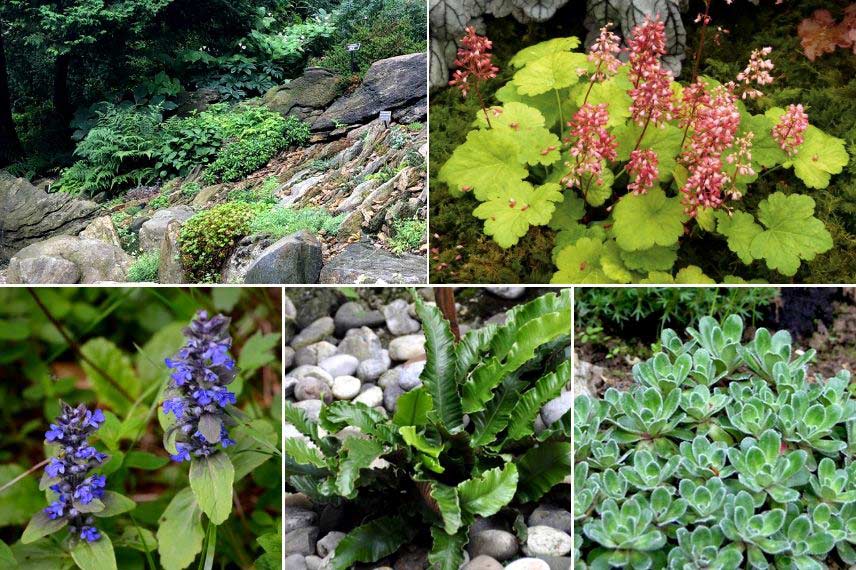
Heuchera ‘Sweet Tart’, Ajuga reptans (photo Radio Tonreg), Asplenium scolopendrium, and Saxifraga arendsii ‘Adebar’ (photo Natali Krmpotic Kolic)
Discover other Heuchera
View all →Available in 1 sizes
Available in 0 sizes
Available in 1 sizes
Available in 1 sizes
Available in 0 sizes
Available in 1 sizes
Available in 1 sizes
Available in 2 sizes
Available in 1 sizes
Available in 1 sizes
To create a container planting
Relatively compact, heucheras can be grown in a pot where their foliage will enliven a composition. Choose a pot large enough to include different young plants without them feeling cramped. For the flowers, plant spring bulbs such as tulips, muscaris, hyacinths or daffodils. Don’t hesitate to let the foliage of ivy, Muehlenbeckia or a hardy geranium (for example ‘Orion’, whose long stems will cascade) trail over the rim of the pot. Small grasses, such as Carex testacea, will add a little volume and lightness. You can then place the composition near your house, for example on the patio, preferably in partial shade or in sun that is not scorching.
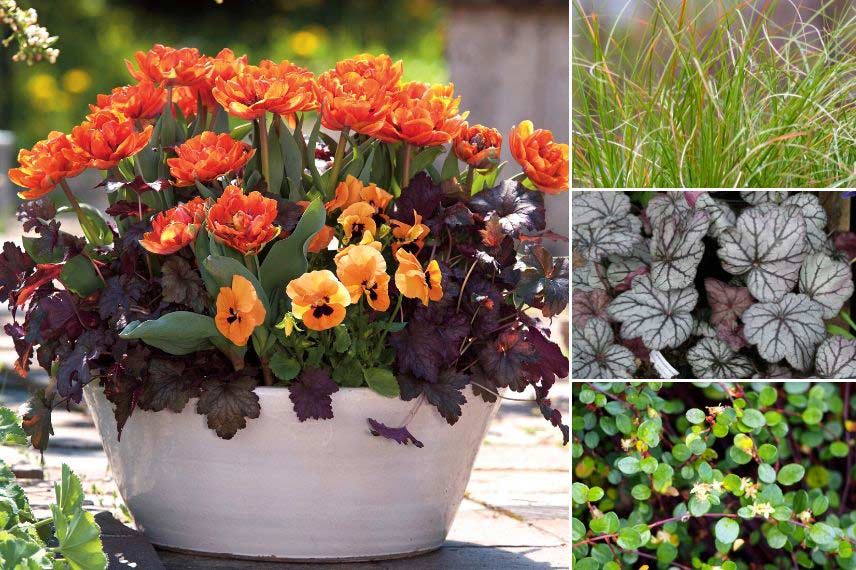
A composition featuring tulip ‘Orange Princess’, heuchera ‘Amethyst Myst’, and orange pansies with a black macule (photo Friedrich Strauss‑Biosphoto) / Carex testacea / Heuchera ‘Sugar Plum’ / Muehlenbeckia axillaris (photo Agnieszka Kwiecień, Nova)
Read also
Heucheras: planting, growing and careIn a border of warm colours
Heucheras with brown or copper leaves are stunning when paired with yellow, red or orange flowers. You can create a splendid, blazing display by planting at the front edge the Heuchera ‘Marmelade’ or the Heuchera ‘Caramel’, whose colour evolves over time. Behind them, place warm-toned tulips (for example ‘Ballerina’), Carex comans ‘Bronze Form’, the wallflower ‘Winter Passion’ and Euphorbia griffithii ‘Fireglow’. With their similar colours, you will have no difficulty achieving a very harmonious effect! In late spring, their flowering will be followed by that of Geum chiloense ‘Mrs Bradshaw’, then potentilla ‘Gibson’s Scarlet’, Oriental poppy ‘Brilliant’ and sage Salvia jamensis ‘Flammenn’. Also include in the border the coloured foliage of Hakonechloa macra ‘Nicolas’. As well as creating a harmonious display, these warm tones will catch the eye and bring vitality and dynamism to your garden!

Heuchera ‘Marmelade’ (photo Dominicus Johannes Bergsma), tulips, Carex comans, wallflower ‘Winter Passion’, and daffodils
How to bring light to a woodland garden
As they prefer shady spots, use heucheras to create a beautiful natural woodland scene. Choose, for example, Heuchera ‘Dales Strain’ for its fairly natural habit, or ‘Lime Rickey’ for its exceptionally bright foliage. Queens of naturalistic woodland are the ferns: their presence instantly gives a free, wild feel with lots of volume. Choose, for example, Dryopteris wallichiana or Matteuccia struthiopteris. Take inspiration from French forests by incorporating native plants, such as Geranium nodosum, Solomon’s seal, bluebells or ramsons. For a bit more colour, choose Bleeding hearts and purple foxglove.
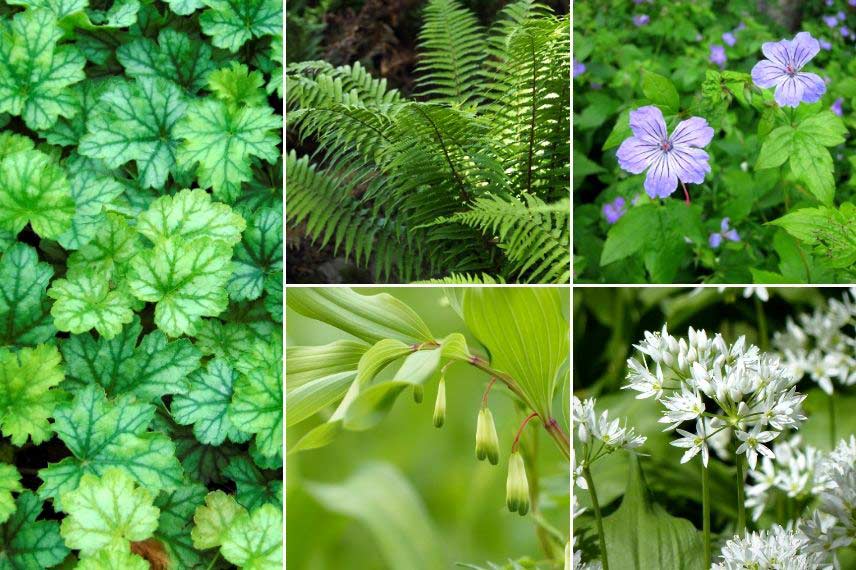
Heuchera ‘Paris’, Dryopteris wallichiana, Geranium nodosum, Polygonatum odoratum and Allium ursinum
With plants that add volume and airiness
As Heuchera is a low-growing plant with broad, thick leaves, it is worth lightening the border by adding plants with a finer, airier habit, which will bring a little volume. You will thus obtain a pleasing contrast of form! Place Heuchera at front of border and position behind it ornamental grasses (for example Deschampsia cespitosa) for their fine, light foliage. Also consider ferns, such as Adiantum aleuticum or Dryopteris affinis. With their dissected foliage and feathery inflorescences, Astilbes are also excellent for adding volume and lightness. Incorporate delicate flowering: in spring enjoy forget-me-nots, columbines, Tiarella, sweet woodruff; in summer bellflowers (for example Campanula trachelium), thalictrums, Japanese anemones… Also discover Aegopodium podagraria ‘Variegata’, a perennial that offers white flowering in umbels, as well as foliage variegated with white, very bright!
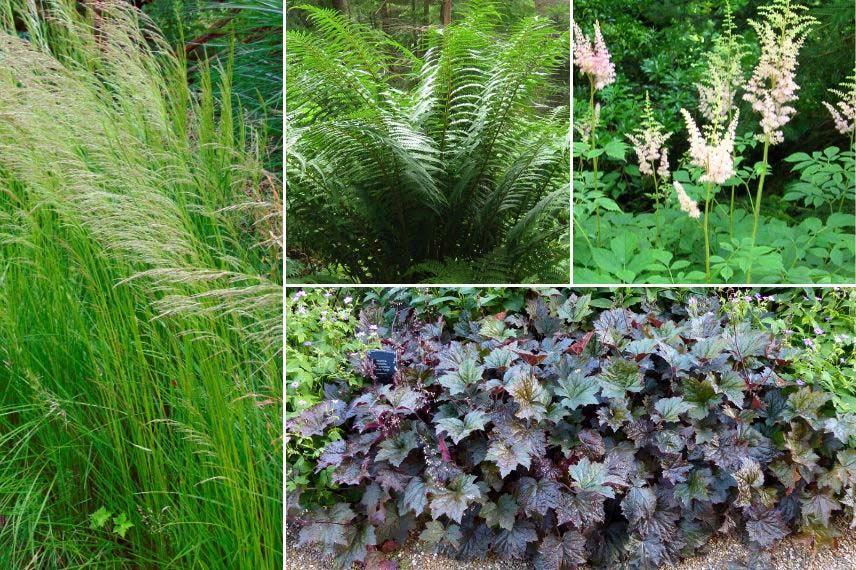
Deschampsia cespitosa ‘Goldschleier’, Dryopteris affinis (photo MPF), Astilbe thunbergii, and Heuchera micrantha ‘Palace Purple’
To showcase flowering of spring bulbs!
Heuchera can also serve as a superb setting that brings out brilliance of colourful flowering. Choose varieties with dark leaves, such as the Heuchera ‘Obsidian’. You’ll achieve a superb result by planting it with the tulip ‘Orange Princess’, an elegant double-flowering variety. Its flowering will appear even more intense! You can also plant muscari, hyacinths, narcissi… Moreover, because these spring bulbs disappear in summer after flowering, Heuchera has the advantage of concealing their yellowing foliage and occupying the space to avoid leaving a gap in the border.
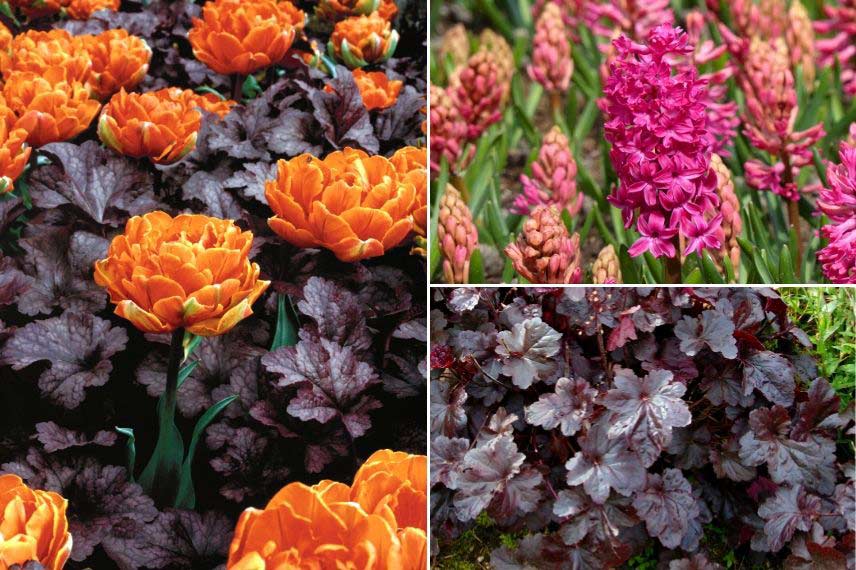
Heuchera ‘Chocolate Ruffles’ and Tulip ‘Orange Princess’ photo Nicola Stocken Tomkins – Gardenpix – Biosphoto), Hyacinth ‘Jan Bos’, and Heuchera ‘Obsidian’
- Subscribe!
- Contents
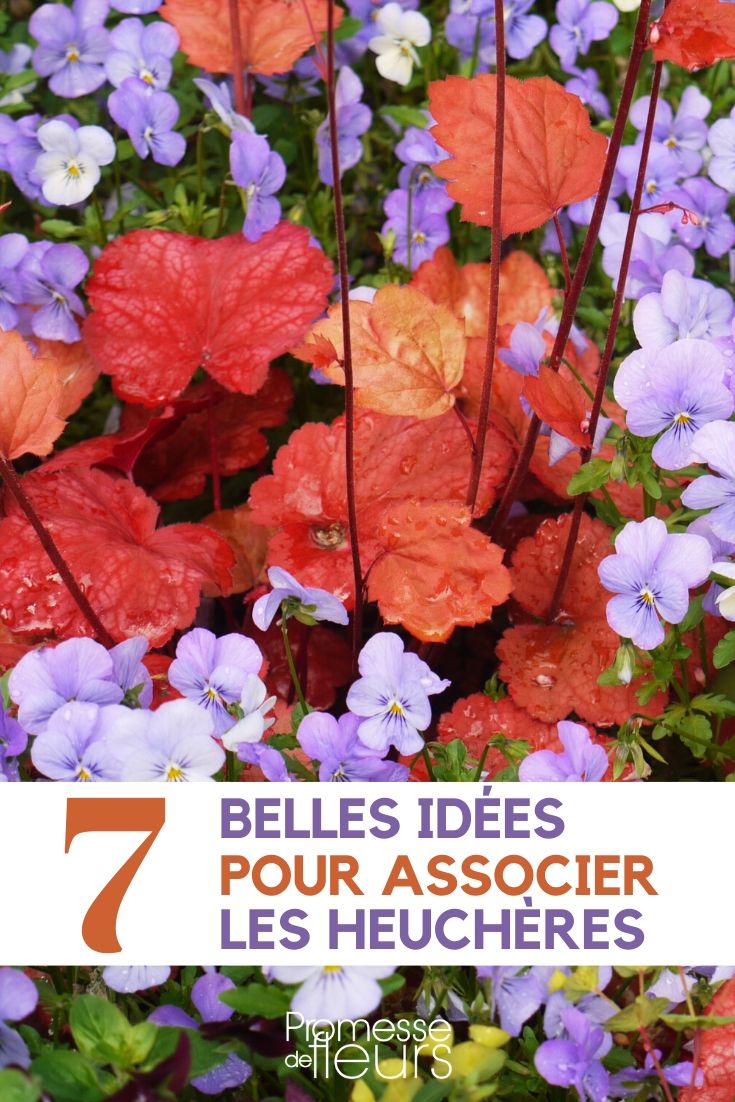































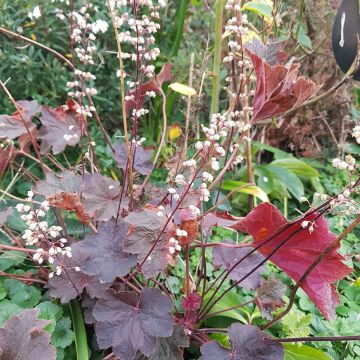

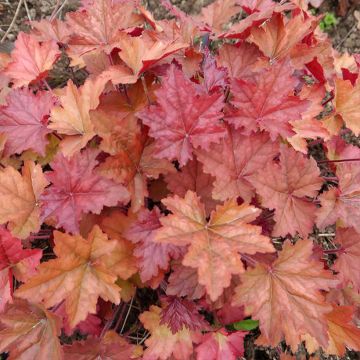
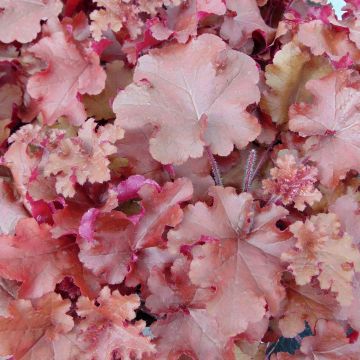
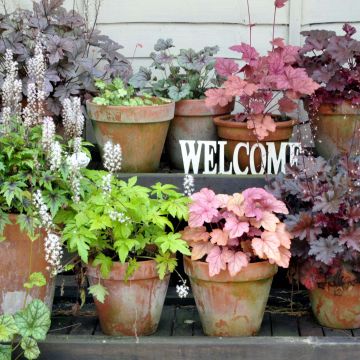
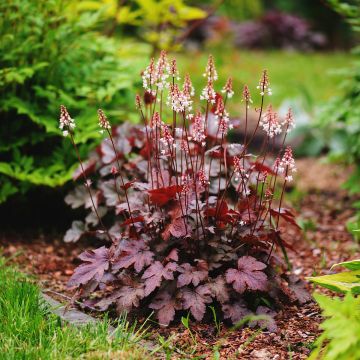

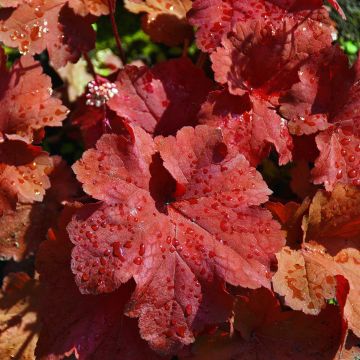
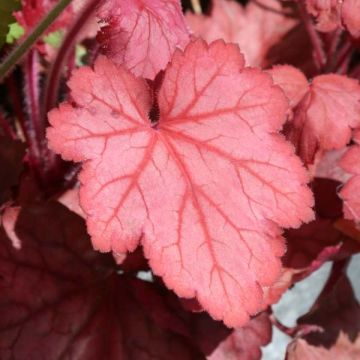
Comments